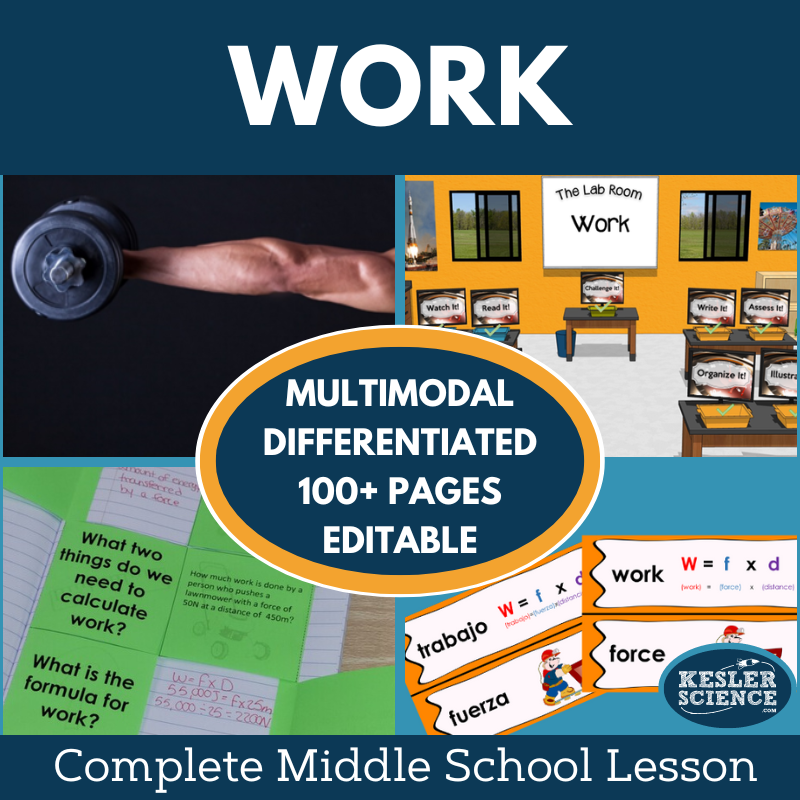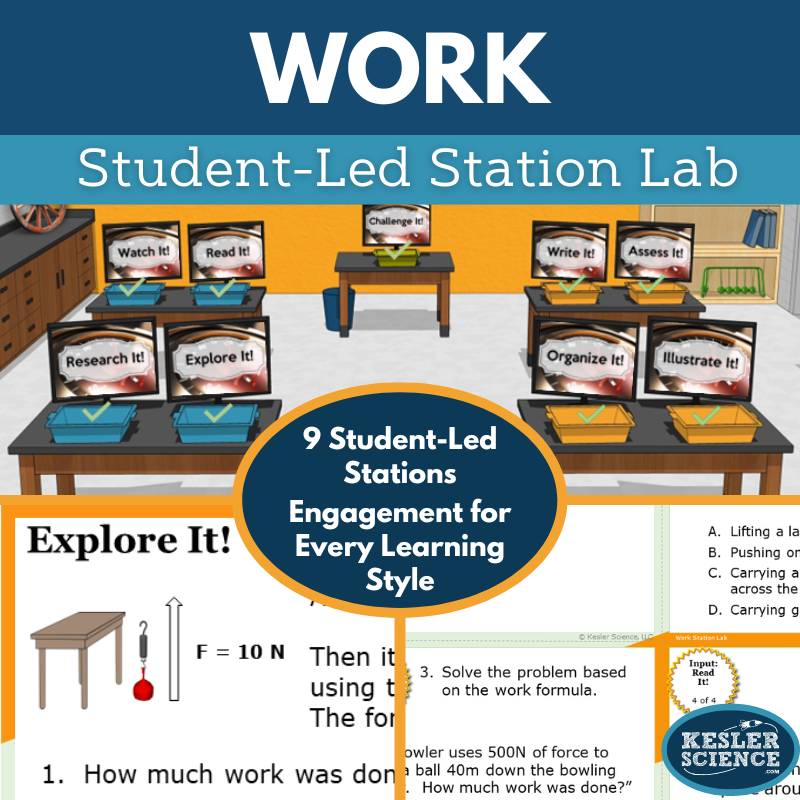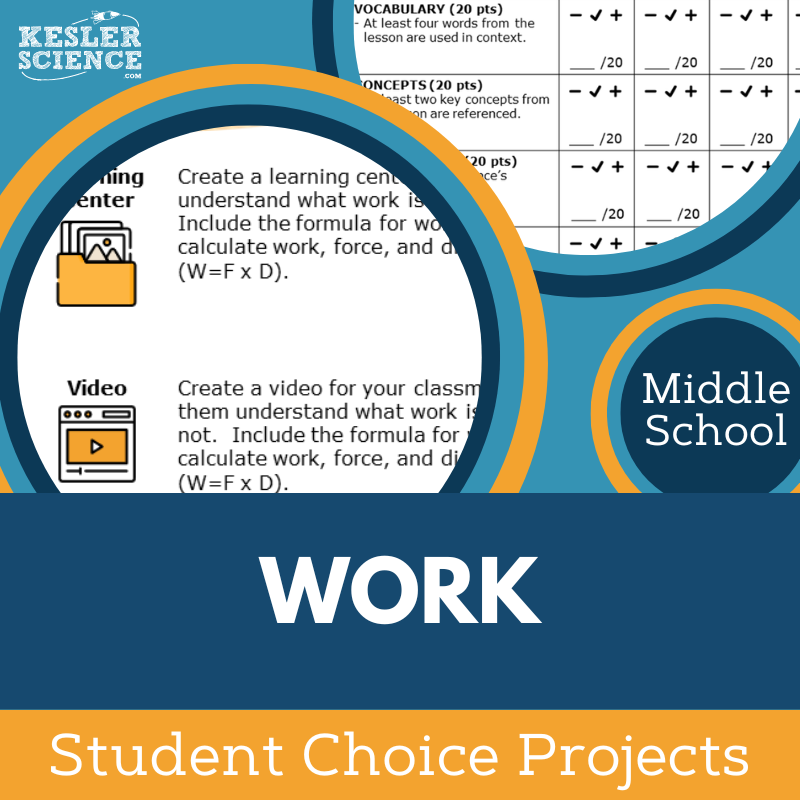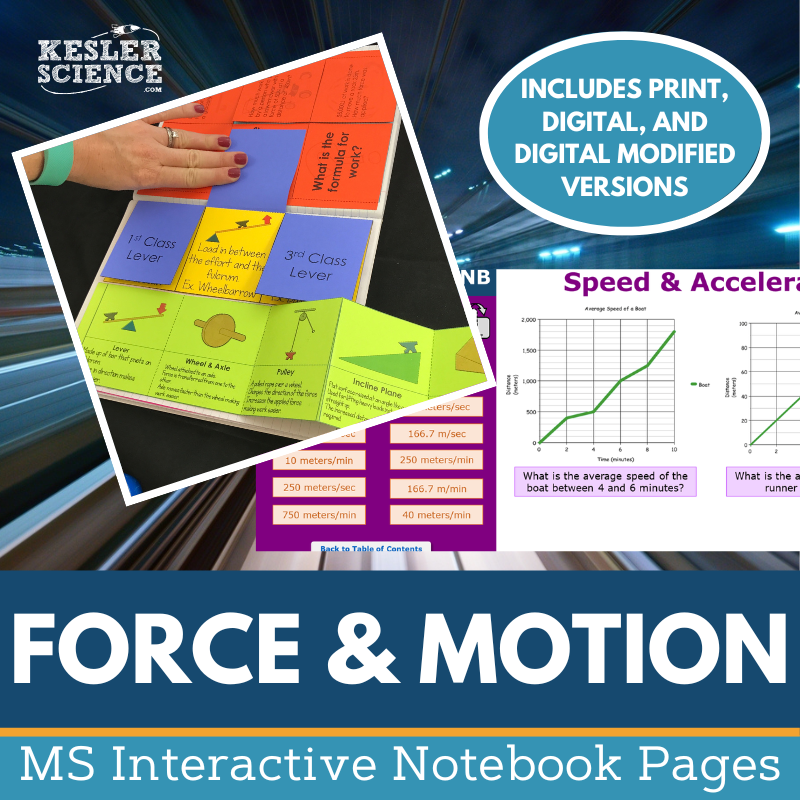Work Activities for Middle School Science
The Kesler Science Work resources offer a comprehensive, engaging approach to teaching middle school students about work and force. The resources below will give students a comprehensive understanding of work. All of the following materials are also included in the Kesler Science Membership.
This comprehensive middle school unit helps students evaluate when work is done in different situations by comparing scenarios that involve varying amounts of force and motion. Built around the 5E instructional model, the lesson includes editable presentations, worksheets, student-choice projects, and assessments to support differentiated, student-led learning with minimal prep time. Essential questions guide students as they explore work done in everyday contexts, such as moving a box with or without a ramp.
During the Exploration phase, students rotate through nine multimodal station labs, including reading passages in English and Spanish, hands-on experiments, videos, websites, and creative response activities like drawing, organizing, and writing. A bonus "Challenge It!" station offers additional enrichment for early finishers. The Explanation phase features editable PowerPoints and interactive notebook templates to support notetaking and content mastery. Materials are offered in both digital and print formats for maximum classroom flexibility.
To extend and assess learning, students complete optional projects during Elaboration and demonstrate understanding through differentiated evaluations aligned with STAAR 2.0 standards. With built-in supports for in-person and virtual instruction, this TEKS-aligned resource provides everything needed for an engaging and rigorous unit on work and force.
This comprehensive middle school unit helps students evaluate when work is done in different situations by comparing scenarios that involve varying amounts of force and motion. Built around the 5E instructional model, the lesson includes editable presentations, worksheets, student-choice projects, and assessments to support differentiated, student-led learning with minimal prep time. Essential questions guide students as they explore work done in everyday contexts, such as moving a box with or without a ramp.
During the Exploration phase, students rotate through nine multimodal station labs, including reading passages in English and Spanish, hands-on experiments, videos, websites, and creative response activities like drawing, organizing, and writing. A bonus "Challenge It!" station offers additional enrichment for early finishers. The Explanation phase features editable PowerPoints and interactive notebook templates to support notetaking and content mastery. Materials are offered in both digital and print formats for maximum classroom flexibility.
To extend and assess learning, students complete optional projects during Elaboration and demonstrate understanding through differentiated evaluations aligned with STAAR 2.0 standards. With built-in supports for in-person and virtual instruction, this TEKS-aligned resource provides everything needed for an engaging and rigorous unit on work and force.
Engage your middle school students in a student-led, differentiated station lab focused on the concept of work in physical science. This modular activity helps students compare situations where work is and isn’t done, depending on the amount of force applied. Designed to minimize teacher prep, the lab promotes active learning through independent or small group exploration. It is also included as part of the broader Work 5E Lesson Plan.
The station lab includes nine learning stations that blend input and output tasks. Students rotate through hands-on, research-based, reading, and video-based stations to gain foundational knowledge, then demonstrate understanding through writing, drawing, organizing, and assessment activities. Each station is scaffolded for diverse learners, with a bonus challenge station available for early finishers or advanced students. Spanish and English reading passages are also included for additional differentiation.
This versatile resource supports in-person and virtual instruction with materials compatible with PowerPoint and Google Slides. Students can engage with content through interactive digital elements or traditional hands-on formats, making this lab a flexible and powerful tool for science instruction.
Engage your middle school students in a student-led, differentiated station lab focused on the concept of work in physical science. This modular activity helps students compare situations where work is and isn’t done, depending on the amount of force applied. Designed to minimize teacher prep, the lab promotes active learning through independent or small group exploration. It is also included as part of the broader Work 5E Lesson Plan.
The station lab includes nine learning stations that blend input and output tasks. Students rotate through hands-on, research-based, reading, and video-based stations to gain foundational knowledge, then demonstrate understanding through writing, drawing, organizing, and assessment activities. Each station is scaffolded for diverse learners, with a bonus challenge station available for early finishers or advanced students. Spanish and English reading passages are also included for additional differentiation.
This versatile resource supports in-person and virtual instruction with materials compatible with PowerPoint and Google Slides. Students can engage with content through interactive digital elements or traditional hands-on formats, making this lab a flexible and powerful tool for science instruction.
The Work Student Choice Projects align with NGSS standards and give middle school students the opportunity to demonstrate their understanding in creative and personalized ways. Students select from six project options and a “design your own” choice, with an editable rubric that supports teacher, peer, or self-assessment. The project options accommodate a range of learning styles, allowing students to showcase their knowledge in multimodal formats.
To support differentiation, the resource includes two versions of the project page—one with modified tasks for students needing extra support and another that allows for challenge through multi-project assignments using a single rubric. Teachers can adjust the rubric to fit their classroom grading needs. These projects can be completed using common classroom supplies like paper, scissors, and markers, and many options are suitable for digital completion.
The Work Student Choice Projects align with NGSS standards and give middle school students the opportunity to demonstrate their understanding in creative and personalized ways. Students select from six project options and a “design your own” choice, with an editable rubric that supports teacher, peer, or self-assessment. The project options accommodate a range of learning styles, allowing students to showcase their knowledge in multimodal formats.
To support differentiation, the resource includes two versions of the project page—one with modified tasks for students needing extra support and another that allows for challenge through multi-project assignments using a single rubric. Teachers can adjust the rubric to fit their classroom grading needs. These projects can be completed using common classroom supplies like paper, scissors, and markers, and many options are suitable for digital completion.
The Kesler Science Force and Motion Interactive Notebook offers a dynamic way to engage students in learning key physics concepts. This resource includes both print and digital versions, making it adaptable for any classroom setting, including traditional, 1:1 environments, and distance learning.
The notebook covers essential topics such as speed, velocity, acceleration, Newton’s laws, simple machines, and motion graphing. The digital version includes a PowerPoint file that can be uploaded to platforms like Google Slides, MS Teams, or Canvas. It also features reflection pages, space for note-taking, and a modified version for students with accommodations.
For in-person learning, the paper version provides blank and pre-filled templates with color photos for easy use. Whether online or in the classroom, the Force and Motion Interactive Notebook is a versatile tool that helps students actively engage with and understand the material.
The Kesler Science Force and Motion Interactive Notebook offers a dynamic way to engage students in learning key physics concepts. This resource includes both print and digital versions, making it adaptable for any classroom setting, including traditional, 1:1 environments, and distance learning.
The notebook covers essential topics such as speed, velocity, acceleration, Newton’s Laws, simple machines, and motion graphing. The digital version includes a PowerPoint file that can be uploaded to platforms like Google Slides, MS Teams, or Canvas. It also features reflection pages, space for note-taking, and a modified version for students with accommodations.
For in-person learning, the paper version provides blank and pre-filled templates with color photos for easy use. Whether online or in the classroom, the Force and Motion Interactive Notebook is a versatile tool that helps students actively engage with and understand the material.
Year-Round Resources
These year-round activities will increase your students' understanding of many middle school science topics. All of these activities are also included in the Kesler Science Membership.
Visual Data & Graphing
You're not alone if your students struggle with understanding graphs, charts, and tables. It's a skill that takes an enormous amount of practice. This resource will help students build a strong foundation in analyzing data and creating their own data visualizations.
Bell Ringers and Warm-Ups
These middle school science bell ringers are an excellent way to engage your students as soon as they walk into your classroom. This comprehensive FULL YEAR resource includes everything you need to start off each science class with an interesting warm-up activity.
Review Board Games
Each game board has been carefully designed to keep students engaged. There are 10 different action spaces on each board and dozens of question cards. All of the actions are related to science concepts and keep the students motivated throughout the game.
Each game is ready to play. Simply print out the board and the cards and let the students enjoy reviewing nine different units.
Essential Questions
Below are the essential questions associated with the lessons and activities included in this unit. This topic is only one of more than 100 middle school science topics included in the Kesler Science Membership.
-
How can you compare situations where work is done with different amounts of force to situations where no work is done?
-
Determine when work is done moving a box with and without a ramp, or standing still?
Kesler Science Membership
Imagine never having to search for another middle school science lesson again. The membership gives you access to ALL of the Kesler Science products in one place (Yes, including everything above).
Say goodbye to long hours of lesson prep.









